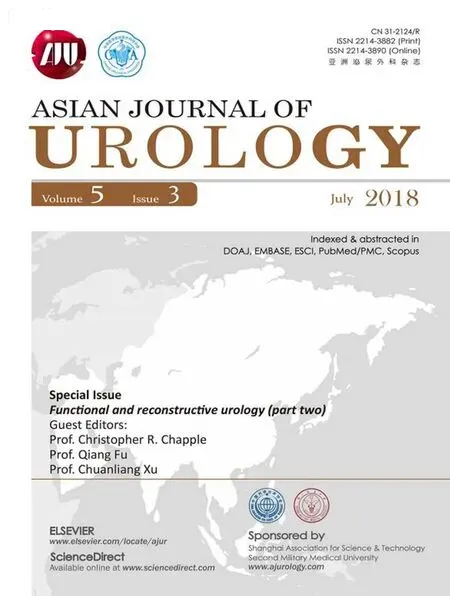Functional and reconstructive urology(part two)
Dear Colleagues,
This second special edition of the Asian Journal of Urology reviews a number of other important aspects of functional and reconstructive urology.
As mentioned in the last special edition,there is a significant ageing of the population in most countries but also a still limited understanding of the structure,innervation and functional pathophysiology seen as an underlying etiological factor in the development of lower urinary tract dysfunction.The article by Lori A.Birder and colleagues[1]emphasises a number of the aspects of pathophysiology seen in the ageing bladder,with reference to existing experimental research in this field.Clearly,work such as this gives us considerable insight into how we can develop new techniques for the future.
In current practice there is a great deal of interest in the management of stress urinary incontinence,particularly inspired by current concerns over the use of synthetic polypropylene mesh in contemporary practice.A comprehensive overview of contemporary diagnostics and treatment options for female stress urinary incontinence which is very topical is provided by Allert M.de Vries and John P.F.A.Heesakkers[2].
Fistulae result in catastrophic symptoms for patients and in contemporary practice rectourethral fistulae,which may also occur as a result of congenital abnormalities and trauma,are increasingly being seen following radical excisional surgery for prostate cancer and the management of these acquired rectourethral fistulae is described by Shulian Chen and colleagues[3].
It is very important to also focus on reconstructive challenges in the female patient.In this context,two articles address the subject of vesicovaginal fistulae.These are an important clinical problem which can be effectively managed in experienced hands,and the choice of an appropriate surgical approach is summarised by Christopher J.Hillary and Christopher R.Chapple[4].In some cases if there is a very small fistula then tissue healing can be encouraged by electrocauterisation ofthe tract,as outlined by Weiyu Zhang and colleagues[5].However,it must be emphasised that careful case selection is important and ultimately fistula representing a mature tract between the bladder and an adjacent epithelial surface represents an area of poor blood supply.Unless the fistula is very small then optimal results are only obtained if new blood supply has been brought in using vascularised tissue interposition.
In recent years,it has also been recognised that careful assessment and management of female patients with urethral pathology is essential and in the article by Reem Aldamanhori and Richard Inman[6],this is addressed in detail.
Before undertaking any major surgical intervention,an adequate diagnostic algorithm needs to be considered to identify the underlying problem and thereby appropriately consent the patient about the feasible treatment options.
In the last special edition two articles considered the management of posterior urethral stricture disease,from India and China respectively[7,8],and a further article is published here from Emilio Ríos and Luís Martínez-Pi?eiro from Spain,concerning the treatment of posterior urethral stenosis following pelvic fracture[9].
It is very important not to forget reconstruction of the upper urinary tract and a common congenital abnormality,namely that of uretero-pelvic junction obstruction,is in fact one of the earliest reconstructive procedures in urology.This is discussed in the article by Jens Rassweiler and colleagues[10]who present a matched-paired analysis and review of the literature and consider a potential congenital abnormality where there are crossing vessels as a causative factor for the obstruction.
I hope you have enjoyed these two issues of the journal which highlight the breadth of expertise which is necessary to adequately carry out an effective reconstruction of the urinary tract.It is important to recognise that there is“no such thing as brave surgeons,just brave patients”but also that no surgeon should undertake this surgery without adequate training and without the breadth of knowledge to feel secure to complete the procedure successfully,bearing in mind that most reconstructive procedures have to be considered to be a two-phase approach where the underlying disorder is “taken apart” before “being put together again”.
Conflicts of interest
The authors declare no conflict of interest.
 Asian Journal of Urology2018年3期
Asian Journal of Urology2018年3期
- Asian Journal of Urology的其它文章
- The treatment of complex female urethral pathology
- The choice of surgical approach in the treatment of vesico-vaginal fistulae
- Contemporary diagnostics and treatment options for female stress urinary incontinence
- The aging bladder insights from animal models
- “Thumb’s off” for acrometastasis of renal cell carcinoma:Is there a role for acrometastasectomy in the era of targeted therapy?
- The impact of urological resection and reconstruction on patients undergoing cytoreductive surgery(CRS)and hyperthermic intraperitoneal chemotherapy(HIPEC)
